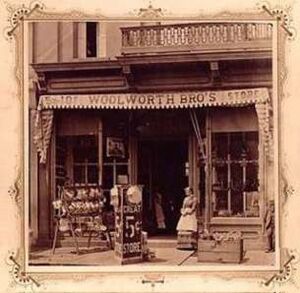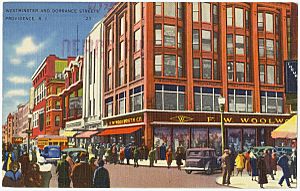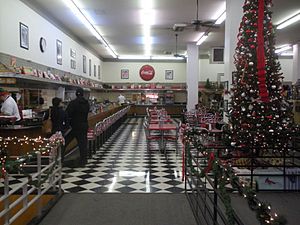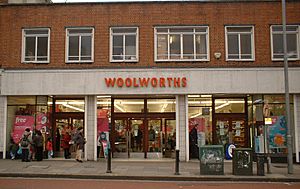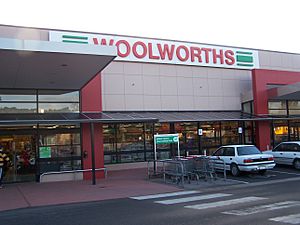F. W. Woolworth Company facts for kids
Last pre-1997 logo
|
|
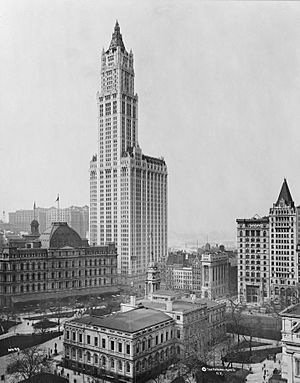
The Woolworth Building, New York City, around 1913
|
|
|
Trade name
|
Woolworth's or Woolworth & Co |
|---|---|
| Public | |
| Traded as | NYSE: Z (1912–1997) |
| Industry | Retail |
| Fate | Department stores closed. Name changed in 1997 to Venator Group, and in 2001 to Foot Locker |
| Successor | Foot Locker (1974–present) |
| Founded | February 22, 1879 Utica, New York, United States |
| Founder | Frank Winfield Woolworth (President) |
| Defunct | July 1997 (said division only) |
| Headquarters | Woolworth Building, Manhattan, New York City, New York, United States |
|
Key people
|
F.W. Woolworth (Founder/CEO) Charles Woolworth (Chairman) |
| Products | Clothing, footwear, bedding, furniture, jewelry, beauty products, consumer electronics and housewares |
| Owner | Independent |
| Parent | Woolworth Corporation, LLC. |
| Subsidiaries | Woolworths Group F. W. Woolworth Ireland Woolworth Canada Woolworth GmbH Woolworth Mexicana Kinney Shoe Company Woolco Woolworth Athletic Group Richman Brothers |
The F. W. Woolworth Company, often called Woolworth's, was a famous retail company. It was one of the first "five-and-dime" stores. These stores sold many different items for very low prices, usually five or ten cents. Woolworth's was very successful in America and around the world. It helped create the modern way stores work today.
Frank Winfield Woolworth opened the first Woolworth store on February 22, 1879. It was called "Woolworth's Great Five Cent Store" in Utica, New York. This first store didn't do well. Frank then tried again in Lancaster, Pennsylvania, on July 18, 1879. This time, his store was a big success. He soon brought his brother, Charles Sumner Woolworth, into the business.
The Woolworth brothers were pioneers in how stores buy, sell, and serve customers. Their ideas are still used today. Woolworth's grew into one of the largest retail chains in the world. But by the 1980s, more competition made it harder for them. The company closed its department stores in July 1997. It decided to focus on sporting goods instead. The company changed its name to Venator Group. In 2001, it became Foot Locker, Inc., focusing only on sports items.
Some stores outside the U.S. still use the Woolworth name. These include stores in Austria, Germany, Mexico, and the United Kingdom. The Woolworths supermarkets in Australia and New Zealand are different companies. They have no link to the original F. W. Woolworth Company. However, they did take their name from the original company. In South Africa, Woolworths Holdings Limited also uses the name. It sells goods similar to Marks & Spencer stores. This company also has no connection to the American Woolworth's.
The History of Woolworth's
How Woolworth's Started
F.W. Woolworth Co. created the first "five-and-dime" stores. These stores sold general goods at low, fixed prices. This was cheaper than other local shops. Woolworth's was one of the first American stores to let customers touch and choose items themselves. Before this, shoppers had to ask a clerk for everything.
Frank Winfield Woolworth worked in a dry goods store. He then got money from his old boss and his own savings. He used this to open his first "Woolworth's Great Five Cent Store" in Utica, New York. This was on February 22, 1879. The store closed a few months later.
Frank tried again on June 21, 1879, in Lancaster, Pennsylvania. This store was a success. Frank then asked his brother, Charles Sumner "Sum" Woolworth, to join him. Sum managed a new store in Harrisburg, Pennsylvania. This store opened on July 19, 1879. It was called "5¢ Woolworth Bro's Store."
After some changes, the brothers opened their "5¢ & 10¢ Woolworth Bro's Store" in Scranton, Pennsylvania. This was on November 6, 1880. Sum managed this store. He spent a lot of time helping customers and employees. Sales grew steadily. Sum later bought his brother's share of the Scranton store. This made him the first Woolworth Bro's franchisee.
In 1884, Sum partnered with his friend Fred Morgan Kirby. They opened a store in Wilkes Barre. It was called "Woolworth and Kirby." Fred managed this store. Frank was also opening more stores. Sum focused on making his Scranton store look perfect. It had shiny counters and bright lights. This look was soon used by Frank for all F. W. Woolworth stores. Other family members and friends joined them. They formed a group of "friendly rival" five-and-ten-cent stores. Frank helped them buy goods together to save money.
Their cousin, Seymour H. Knox I, also opened a store. It was in Reading, Pennsylvania, called "Woolworth and Knox."
Growing Bigger: Woolworth's Expansion
By 1904, there were six chains of Woolworth-style stores. In 1912, all 596 stores joined together. They became one big company called "F. W. Woolworth Company." Frank Woolworth became the President. Sum Woolworth, Fred Kirby, Seymour Knox, Earle Charlton, and William Moore became Directors and Vice-Presidents. This merger raised over $30 million for the founders.
Sum Woolworth stayed in Scranton. He focused on making stores better, especially in Pennsylvania. He also trained new managers. These managers helped shape Woolworth stores around the world.
In 1900, Frank built a large new building in Lancaster, Pennsylvania. It had five floors of offices above a big store. The roof even had a garden and an outdoor theater. This theater became a popular social spot in town. This project was a practice run for his next big idea.
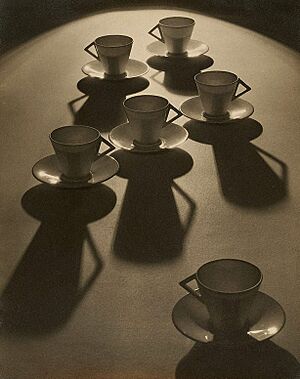
In 1910, Frank Woolworth planned the Woolworth Building in New York City. It was designed by architect Cass Gilbert. Frank paid for the whole building with cash. When it was finished in 1913, it was the tallest building in the world until 1930. It was also the company's main office until 1998.
Frank Woolworth died in 1919. His brother Sum was asked to be President. But Sum was modest and said no. He agreed to be Chairman instead. The company then started selling items for more than ten cents. By 1935, they removed all selling-price limits.
Woolworth stores also added lunch counters. These became popular places for people to meet. A Woolworth’s lunch counter in Greensboro, North Carolina, became famous. It was the site of the 1960 Greensboro sit-ins during the Civil Rights Movement. Many other stores copied the five-and-dime idea. These stores became a common sight in American towns.
Woolworth's Changes and Decline
In the 1960s, Woolworth's started larger discount department stores called Woolco. In 1962, other companies also opened similar discount stores. These included Kmart, Target, and Wal-Mart.
In 1963, Woolworth's bought Kinney Shoe Corporation. This led to the creation of Foot Locker, which the company later became. By 1979, Woolworth's 100th anniversary, it was the largest department store chain in the world.
In the 1980s, the company added many specialty stores. These included Afterthoughts (jewelry), Northern Reflections (outerwear), and Champs Sports. The idea was to have many different types of stores in shopping malls. If one store didn't do well, they could quickly replace it.
However, the company started to struggle. Woolworth's moved away from its original five-and-dime stores. It focused more on specialty stores. But it couldn't compete with other chains. The Woolco chain closed in the United States in 1983. The large Woolworth store in Manchester, England, closed in 1986. In 1993, Woolworth's closed half of its general merchandise stores in the U.S. Canadian stores were changed to a closeout division called The Bargain! Shop. Most Canadian Woolco stores were sold to Wal-Mart in 1994.
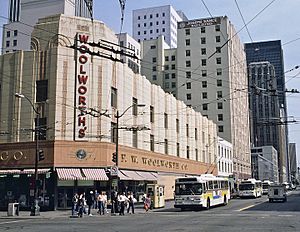
The Company Changes Its Name
As its main stores declined, Woolworth's started focusing on athletic goods. In 1997, it bought the athletic retailer Eastbay.
On March 17, 1997, Wal-Mart replaced Woolworth's in the Dow Jones Industrial Average. Experts said that lower prices from big discount stores hurt Woolworth's. Also, supermarkets started selling items that five-and-dime stores used to sell.
Becoming Venator
On July 17, 1997, Woolworth's closed its last department stores in the U.S. It changed its company name to Venator. In 1999, Venator moved its offices from the Woolworth Building.
Becoming Foot Locker
On October 20, 2001, the company changed its name again. It took the name of its most successful store, Foot Locker, Inc.. Woolworth's had started Foot Locker in 1974. The history of Woolworth's is now part of the history of Foot Locker, Inc.
In 2012, Foot Locker celebrated Woolworth's 100th anniversary on the New York Stock Exchange. They showed pictures of a 1912 Woolworth's store and a 2012 Foot Locker store.
Woolworth's Influence on Culture
- Woolworth was a leader in "five-and-dime" stores.
- In 1880, Woolworth was one of the first to sell manufactured Christmas tree ornaments. They became very popular.
- In 1929, Sam Foster sold sunglasses at a Woolworth's counter in Atlantic City, New Jersey. They were a big hit with beachgoers.
- On February 1, 1960, four African-American students started the Greensboro sit-ins. They sat at a "whites only" lunch counter in the Greensboro, North Carolina, store. This store is now a museum.
- On May 28, 1963, 14 activists protested Jim Crow segregation. They held a sit-in at Woolworth's "whites only" lunch counter in Jackson, Mississippi. This event was very important for the civil rights movement in Jackson. The Civil Rights Act of 1964 was passed the next year.
- A Woolworth's building still exists in Bakersfield, California. It is now an antique store but still has a working diner.
The Greensboro Sit-in
On February 1, 1960, four black students sat at a segregated lunch counter in a Woolworth's store in Greensboro, North Carolina. They were not served because of their race. This event started six months of sit-ins and boycotts. It became a very important moment in the civil rights movement.
In 1993, a part of the lunch counter was moved to the Smithsonian Institution. The store site is now a civil rights museum. It opened on February 1, 2010, exactly 50 years after the sit-ins began.
Similar sit-ins happened in other cities at segregated Woolworth's lunch counters. In Roanoke, Virginia, on August 27, 1960, two women and a boy sat at a lunch counter. They ordered food without any problems. Other sit-ins in Roanoke also happened peacefully.
Leaders of Woolworth's
- Frank Winfield Woolworth (1852–1919) from founding to 1919
- Hubert Templeton Parson 1919 to 1932
- Byron D. Miller 1932 to 1935
- Charles Deyo 1935 to 1946
- Alfred Cornwell 1946 to 1954
- James T. Leftwich 1954 to 1958
- Robert C. Kirkwood 1958 to 1965
- Lester A. Burcham 1965 to 1970
- John S. Roberts 1970 to 1975
- Edward F. Gibbons 1975 to 1978
- W. Robert Harris 1978 to ?
- Robert L. Jennings 1984 to 1987
- Frederick E. Hennig 1987 to 1995
- Jack Adams 1993-1994 (Interim CEO for Restructuring)
- Roger N. Farah 1994 to 2000. Oversaw company's name change to Venator in 1997.
- Matthew D. Serra 2001 to 2009. Oversaw company's name change to Foot Locker in 2001.
- Kenneth C. Hicks, 2009 to 2014.
- Richard A. Johnson, 2014–present.
Woolworth Name Around the World
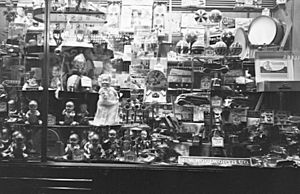
Former Woolworth's Branches
Still in Business Today
- Deutsche Woolworth GmbH & Company OHG (started in 1927) is the German part of F.W. Woolworth. It has been independent since 1998. It owns the Woolworth name rights in continental Europe.
- Woolworth Mexicana runs small variety stores in Mexico. Foot Locker Inc. sold it in 1997. It is now part of Grupo Comercial Control.
No Longer in Business
- Woolworth Canada was the Canadian part of F.W. Woolworth. It started in the 1920s. It had Woolworth stores and other brands like Woolco and Foot Locker. Even after the last Woolworth stores closed in Canada in 1994, the division was still called Woolworth Canada. It later became Foot Locker Canada in 2001.
- Woolworths Group plc was the British part of F.W. Woolworth's. It became a separate company in 1982. It ran stores in the UK and nearby islands. On November 26, 2008, Woolworth's Group plc announced it had too much debt. The remaining British Woolworth's stores closed by January 6, 2009. This caused almost 30,000 job losses.
Other Stores Using the Woolworth Name
- Woolworths Group is the biggest retail company in Australia. It runs supermarkets and other stores in Australia and New Zealand. They used the name "Woolworths" because the original F.W. Woolworth company wasn't in Australia. But they are not connected to the U.S. or U.K. Woolworths.
- Woolworths is a fancy retail chain in South Africa. It sells goods similar to Marks & Spencer stores in the UK. This South African company also has stores in many other countries in Africa and the Middle East.
- Woolworth's in Bridgetown, Barbados, runs independently. It separated from the British branch in 1982. It started in the 1950s, selling goods from Britain.
See also
 In Spanish: Woolworth para niños
In Spanish: Woolworth para niños



